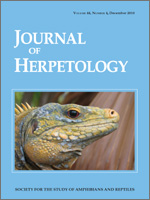We examined Desert Tortoise microhabitat selection on the Florence Military Reservation (FMR) in south-central Arizona where National Guard training and other activities, such as motorized recreation and grazing, are permitted. Previous research on the FMR indicated that Desert Tortoise home ranges overlapped with firing boxes, areas where most of the National Guard's training activity was concentrated. Our objective was to examine Desert Tortoise microhabitat selection within, and adjacent to, these firing boxes in an effort to guide future management for restoring degraded tortoise habitat on the installation. Desert Tortoises selected habitat that was characterized by a higher percentage of canopy cover, absence of cattle activity, and closer proximity to roads and washes than was available within their home range. Canopy cover had the highest calculated parameter importance and was included in each of the supported microhabitat selection models. Areas with sufficient canopy cover most likely provided shade for escaping the desert heat during periods of high tortoise activity. Our results suggest that management prescriptions that maintain, or increase, the amount of vegetative cover and that protect desert washes will have positive impacts on Desert Tortoise populations.
How to translate text using browser tools
1 December 2010
Desert Tortoise Microhabitat Selection on the Florence Military Reservation, South-Central Arizona
David D. Grandmaison,
Michael F. Ingraldi,
Frances R. Peck
ACCESS THE FULL ARTICLE

Journal of Herpetology
Vol. 44 • No. 4
December 2010
Vol. 44 • No. 4
December 2010




